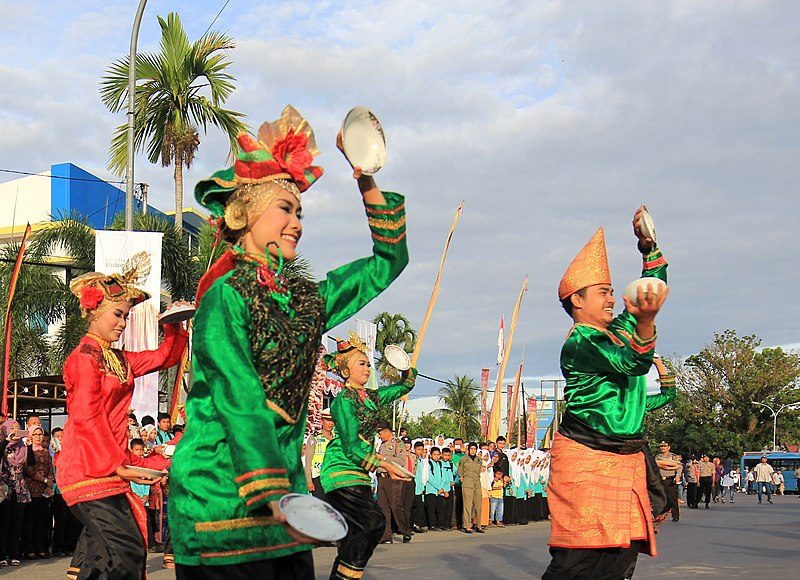Gambyong dance is an art from Indonesia which is a typical Javanese dance. This traditional dance is usually performed by two teenage girls wearing green costumes. This Busan is combined with a batik cloth subordinate, a long yellow scarf wrapped around the waist, and a head ornament. The dancers also went up to the stage accompanied by traditional Javanese songs and music.
The music that accompanies the dance is Javanese music (Javanese music) sung by sinden (singer) and tetabuhan gamelan (Javanese traditional musical instrument). The two dancers walked rather quickly into the stage, then positioned themselves in a line facing the audience as the pangkur music played.
The dancer moves the head, eyes, feet in harmony where the direction of the head and eyes follows the direction of the moving fingertips. While the legs step forward, backward and to the side alternately in time with other body movements and accompaniment music.
Overall, the graceful building movements present a beautiful harmony. This is a description of the dish of Taria Gambyong from Surakarta. Not many people know that the origin of this dance is a folk dance.
Gambyong dance is generally performed during the rice planting and harvest season as a tribute to Dewi Sri. Respect is given because for people in Java, especially Central and East Java, Dewi Sri is a symbol of fertility.
Before being presented in a smooth and harmonious movement, as we see today, the gambyong dance is a tayub dance. Tayub dance is known as social dance. Tayub is very popular in Java and is often served at traditional celebrations in the villages, such as weddings and circumcisions.
However, each region in Java has its own peculiarities in movement and the designation for this social dance. In West Java, this kind of gambyong social dance is known as the jaipong dance. The basic movement of the jaipong is not much different from that of the tayub dance.
Appointed by Sri Gambyong
It was Sri Gambyong, a dancer from Surakarta (Solo) who elevated this folk dance to the Kasunanan Surakarta palace in the era of Paku Buwono (PB) IV. In presenting the tayub dance, Sri Gambyong’s appearance was very stunning, different from the tayub dancers in general.
The ability of this dancer was the topic of conversation among the people in the Surakarta Palace area and was heard by PB IV. Then the Keraton Surakarta invited Sri Gambyong to present a dance in front of the King and the palace environment. After that it was told that the King wanted the Sri Gambyong dance to be adopted and polished again to become the form it is today.
Gambyong dance usually begins with the strains of the pangkur gending which is the initial song to invite the dancers to go on stage. In general, the Gambyong dance movement emphasizes the movements of the legs, hands, body and head. The basic movements that characterize this dance are the head and hand movements.
The uniqueness of this dance can be seen in the eyes of the dancers who often look at the fingers along with the movements of their hands. Then accompanied by harmonious foot movements that follow the music of the accompaniment. The movement of the gambyong dance is slow in tempo, the dancers dance gracefully which depicts the tenderness and beauty of a woman.
The performance of the gambyong dance consists of three parts, namely the initial movement (forward beksan), the main movement (beksan), and the closing movement (backward beksan). When dancing, the dancer often shows elegant facial expressions with a beautiful smile.
Another element of beauty of the Gambyong dance lies in the compactness of the dancers. The gambyong dancers will move their hands, feet and head simultaneously in harmony with the rhythm of the drums. The eye movements will always follow the hand movements that make this dance harmonious.
After entering the palace, gambyong is often used as an entertainment and welcoming dance for guests of honor. Along with the times, this dance is also often performed among the wider community and has become one of the popular traditional dances in Central Java.
Gambyong also experienced new developments and breakthroughs in its movements, giving birth to various types of dances of this kind. Among them are the Gambyong Sala Minulya, Ayun-Ayun, Gambir Sawit, Dewandaru, Mudhatama, Pangkur, and Campursari dances. Are you interested in learning Indonesian culture? Come on, get interesting information and add insight from Indonesiar.com.






























